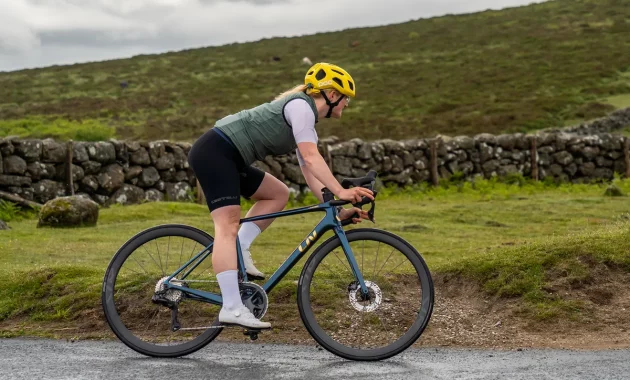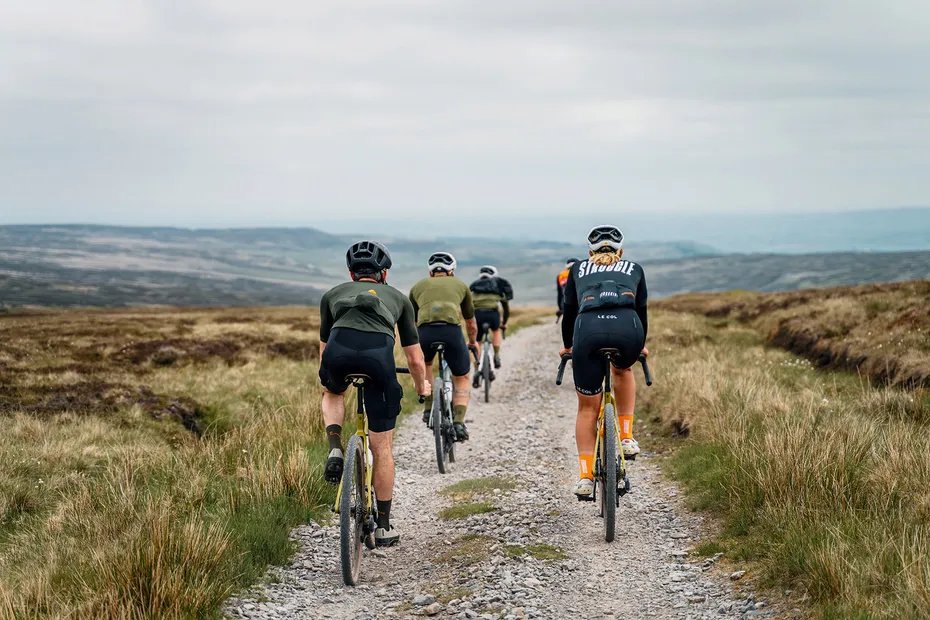Cadence is a key factor in cycling that directly influences your speed, comfort, and overall efficiency. It’s essentially your pedaling rhythm, and getting it right can help you maintain a smooth ride for extended periods. On the other hand, choosing the wrong cadence can lead to discomfort and pain. In this guide, we’ll explain why cadence matters, how it affects your ride, and share training tips from a cycling coach to help you improve your pedaling rate for better performance and comfort.
Table of Contents
What is cadence?

Cadence refers to the number of pedal revolutions you complete per minute while riding. Professional cyclists often have a high cadence, typically around 100 revolutions per minute (rpm) or more. For example, during the 2024 Olympic Women’s Road Race, winner Kristen Faulkner averaged 95rpm, while bronze medallist Lotte Kopecky (93rpm) and fourth-placed Blanka Vas (96rpm) had similar cadences.
Pros tend to pedal slightly slower during climbs but still maintain a cadence much higher than the average cyclist. In stage 15 of the 2024 Tour de France, Derek Gee maintained 88rpm during a stage with nearly 5,000m of elevation. Heavier riders like Jasper Stuyven and Jonas Abrahamsen dropped to around 81rpm.
Tadej Pogačar, a three-time Yellow Jersey winner, climbs at an even higher cadence, possibly due to his shorter crank length. On the Isola 2000 climb during stage 19, he averaged 99rpm over 37 minutes.
By comparison, recreational cyclists tend to pedal at a slower cadence, often around 60rpm, while a fit amateur might reach 80 to 90rpm. If you’re new to cycling, you might need to focus on increasing your cadence for more efficient riding.
Why is cadence important?
Does it matter if you ride with a high or low cadence? The answer is situational.
Cadence plays a key role in your power output, which is a combination of cadence and torque (the force applied to the pedals). The rate at which you pedal also influences which muscles are engaged during cycling.
According to Dr. Xavier Disley of AeroCoach, who has studied cycling efficiency and cadence with elite cyclists, riding at a lower cadence typically places more strain on your muscles. In contrast, a higher cadence shifts the load onto your cardiovascular system.
If you have a muscular build, you’re likely to feel more comfortable pedaling at a lower cadence. Riders with a leaner build may prefer to use a lower gear at higher revolutions. The energy required to spin the legs will vary depending on your physique, according to Disley.
Studies show that trying to maintain speed at a lower cadence (in a harder gear) can lead to muscle strains and soreness, while riding at a higher cadence with less load tends to reduce this risk. Knee pain is often associated with riding at an excessively low cadence.
On the flip side, riding with too high a cadence can cause your pelvis to rock, reducing pedaling efficiency and potentially leading to lower-back discomfort.
Measuring cadence
The easiest way to measure your cadence is by simply counting how many times your legs go up and down within a minute. However, for more precise tracking, a cadence sensor is a better option. High-end power meters typically come with built-in cadence sensors.
Many cadence sensors attach to the left-side chainstay. A magnet on the crank arm passes the sensor, which then counts how many times it crosses in 60 seconds and sends that data to your bike computer.
For example, Wahoo’s RPM Cadence sensor attaches directly to the crank and works independently, transmitting your cadence data wirelessly to your computer.
What is the ideal cycling cadence?
There’s no single “ideal” cadence for every rider. The optimal cadence depends on several factors and can vary from person to person.
Research in lab settings shows that most cyclists naturally choose their optimal cadence based on how much power they can generate relative to their energy use, according to Dr. Xavier Disley. Experience plays a role too—cyclists who’ve spent significant time riding will develop a cadence range that suits them, based on the terrain and demands of a ride.
Disley suggests experimenting with different cadences to find what works best, as the ideal cadence can change depending on the situation. For instance, time trialists often use a higher cadence for shorter events compared to longer ones.
The goal should be to improve your cadence control, not just increase it. Varying your cadence during training helps refine your cycling technique and brings specific performance benefits. High-cadence efforts at low loads train your neuromuscular system for smoother pedaling, while low-cadence, high-load sessions build strength.
Using rollers can help you smooth out your pedaling technique, and structured drills are more effective than long, steady rides for enhancing cadence efficiency.
Two training drills to improve your cadence
We consulted Matt Rowe from Rowe and King coaching to suggest two key training sessions aimed at improving different aspects of cadence: one focused on building strength and the other on enhancing pedaling smoothness. As an experienced coach of professional cyclists and a strong supporter of indoor training, Matt’s workouts are designed to target both power and efficiency.
1. Pedalling fluidity and coordination
Matt Rowe suggests a focused 20-minute session to work on cadence: 4 sets of 4 minutes at 120rpm, followed by 1 minute of easy pedaling. Throughout the entire block, it’s essential to keep your upper body steady, relying on a strong core for stability. The power should come from your legs and hips. For those looking for an extra challenge, you can rest and repeat the session for another round.
2. Strength endurance session
To build strength, Matt Rowe suggests a low-cadence, high-power drill. This involves doing 2 sets of 15-minute efforts at 89-90% of your Functional Threshold Power (FTP), while keeping your cadence between 50-60rpm. The combination of lower cadence and higher power increases torque, helping you develop muscular strength. As you improve, you can gradually increase the power while lowering the cadence even further. Make sure to rest for 10-15 minutes between sets for full recovery.
- Mastering the Art of Solo Cycling: 10 Essential Tips for Success - February 28, 2024
- Core Training for Cyclists : Transform Your Ride - February 27, 2024
- 10 Ways to Enhance Your Breathing for Better Cycling Performance - February 26, 2024

